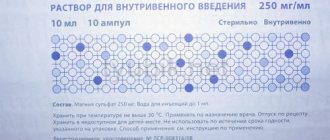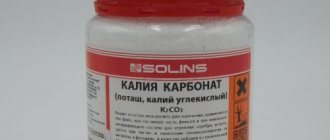Pharmacodynamics and pharmacokinetics
Pharmacodynamics
What is magnesium sulfate? The State Pharmacopoeia defines magnesium sulfate (formula MgSOi) as a medicinal product and indicates the standards for its production and the highest doses of use. The product “magnesium sulfate” is assigned the code OKPD24.42.13.683.
With water, this substance forms hydrates, the most important of which is heptahydrate - bitter, or Epsom salt - this is magnesia , as it is more often called, which is used in medicine. Available in powder form, from which a solution or suspension is prepared for oral administration and in ampoules for intramuscular and intravenous administration.
Depending on the route of administration, it has different effects on the body. injections ) - sedative , diuretic , vasodilator , anticonvulsant hypotensive , antispasmodic , antiarrhythmic , tocolytic , hypnotic .
The mechanism of action as an anticonvulsant is due to the fact that magnesium reduces the release of the neurotransmitter acetylcholine from synapses, suppressing neuromuscular transmission, and has a depressant effect on the central nervous system.
The tocolytic effect (relaxation of the muscles of the uterus) is explained by the fact that magnesium reduces the contractility of the uterus and increases blood flow in it.
The antiarrhythmic effect is due to the stabilization of cell membranes and a decrease in the excitability of cardiomyocytes. Effects after intravenous administration develop immediately, after intramuscular administration - after 1 hour.
When taken orally, it has a choleretic effect and serves as a laxative , which is used for constipation or to cleanse the intestines, for blind probing, poisoning with salts of heavy metals (it is an antidote). The laxative effect is due to poor absorption in the intestine, in which osmotic pressure increases and water accumulates, which leads to dilution of the intestinal contents and increased peristalsis.
The injection solution can be used orally as a laxative. The onset of effect when taken orally after 1-3 hours, lasts 4-6 hours.
Magnesium sulfate has also found its use in cosmetology in the manufacture of emulsions, lotions and creams. It is used as a relaxing bath salt that relieves muscle tension.
Pharmacokinetics
When administered parenterally (injections), it penetrates the BBB. In breast milk it creates concentrations that are 2 times higher than the concentrations in the blood. Excreted by the kidneys, the rate of excretion is proportional to the level of glomerular filtration. diuresis increases .
When administered orally, it is poorly absorbed from the intestine. With malabsorption and consumption of fatty foods, magnesium absorption is reduced. Deposited in bones, muscles, kidneys, myocardium.
Pharmacological action of Magnesium sulfate
In the case of parenteral administration, Magnesium sulfate has a sedative, hypotensive, anticonvulsant, diuretic, antiarrhythmic, arteriodilatating, vasodilating effect.
High doses of Magnesium sulfate have a depressant effect on neuromuscular transmission, have a hypnotic, tocolytic, narcotic effect, and cause suppression of the respiratory center.
Magnesium sulfate, when taken orally, has a laxative and choleretic effect.
Magnesium is a physiological slow calcium channel blocker. Regulates interneuronal transmission, metabolic processes, muscle excitability, increases diuresis, reduces high blood pressure, relaxes smooth muscles.
Magnesium sulfate acts as an antidote for poisoning with heavy metal salts, as it converts them into insoluble and non-absorbable salts.
The anticonvulsant effect of the drug is associated with a reduction in the release of acetylcholine from neuromuscular synapses, while magnesium suppresses neuromuscular transmission and depresses the central nervous system.
The antiarrhythmic effect is due to the restoration of ionic balance, a decrease in the excitability of cardiomyocytes, disruption of sodium current, stabilization of cell membranes, one-way potassium current, and slow incoming calcium current.
The tocolytic effect is due to the inhibition of myometrial contractility under the influence of magnesium ions, increased blood flow in the uterus due to the dilation of its vessels.
The cardioprotective effect is associated with the expansion of the coronary arteries, a decrease in platelet aggregation and peripheral vascular resistance.
Indications for use
- hypomagnesemia , tetany ;
- ventricular tachycardia;
- arterial hypertension , crisis state with cerebral edema ;
- urinary retention;
- brain concussion;
- encephalopathy , epileptic seizure ;
- poisoning with barium chloride , salts of heavy metals ;
- bronchial asthma (as part of complex therapy).
Magnesium Sulfate powder is used orally for:
- constipation;
- gallbladder dyskinesias , cholangitis and cholecystitis (for tubing);
- duodenal intubation;
- poisoning with salts of heavy metals;
- to cleanse the intestines.
Advantages and disadvantages
Advantages of magnesium sulfate as a fertilizer:
- absolute compatibility with nitrogen and phosphorus fertilizers, with humic nutrients, and with multicomponent mineral additives;
- there is no nitrogen in the composition, it is added throughout the season (in July and August, nitrogen is undesirable for plants);
- an overdose is practically impossible - the plant will extract exactly as much beneficial nutritional microflora as it needs; the remainder goes into stock;
- an excellent “antidepressant” for plants - the drug protects green mass from aggressive sunlight, increases the resistance of perennials to cold and frost;
- fertilizer is affordable.
Contraindications for Magnesium Sulfate
- arterial hypotension;
- severe chronic renal failure;
- severe bradycardia ;
- hypersensitivity;
- AV block;
- period before childbirth (2 hours);
- depression of the respiratory center.
Prescribed with caution for myasthenia gravis . Contraindications for oral administration: appendicitis , intestinal bleeding , intestinal obstruction , dehydration (dehydration) .
Contraindications
According to the instructions, Magnesium sulfate is contraindicated in case of hypersensitivity to the drug or severe chronic renal failure.
Magnesium sulfate powder should not be taken if:
- appendicitis;
- rectal bleeding;
- intestinal obstruction;
- dehydration.
Magnesium sulfate solution in ampoules is not administered if:
- AV block;
- arterial hypotension;
- depression of the respiratory center;
- severe bradycardia;
as well as in the prenatal period.
Side effects
With intravenous use: headache, polyuria, decreased blood pressure, nausea, severe sedation, uterine atony .
Signs of hypermagnesemia : bradycardia, double vision, shortness of breath, slurred speech, asthenia, decreased and loss of tendon reflexes, depression of the respiratory center and impaired cardiac conduction.
When taken orally: vomiting, diarrhea , exacerbation of gastrointestinal diseases, flatulence , thirst, intestinal pain, electrolyte imbalance (fatigue, asthenia, convulsions).
Instructions for use of Magnesium Sulfate (Method and dosage)
Instructions for use of the solution in ampoules
A 25% solution is most often used intravenously or intramuscularly. For hypertensive crises , convulsive syndrome , spastic conditions, 5–20 ml of the drug is prescribed.
For eclampsia - 10 - 20 ml of 25% solution up to 4 times a day.
To relieve seizures in children, 0.1-0.2 ml per kg of weight of a 20% solution is administered intramuscularly.
For acute poisoning - 5-10 ml 10% solution intravenously.
Magnesium Sulfate powder, instructions for use
How to take magnesium sulfate as a laxative? Powder in an amount of 20-30 g is dissolved in 100 ml of water (preferably warm) and drunk at night or in the morning half an hour before meals. For chronic constipation, enemas are given - the same amount of powder per 100 ml of water. The drug can be used as a laxative only occasionally.
Method of using powder as a choleretic agent
Prepare a solution from 20 g of powder and 100 ml of water. Take 1 tablespoon 3 times a day before meals. In case of poisoning with salts of heavy metals, take a solution orally - 20-25 g per 200 ml of water. During duodenal intubation , 50 ml of a 25% solution is injected through the probe.
Magnesium sulfate is also used as a fertilizer; a separate section is devoted to this.
Application as fertilizer
Magnesium sulfate is a fertilizer that is a source of magnesium and sulfur for agricultural and ornamental crops. This fertilizer is white crystals, highly soluble in water. Accelerates the growth of new shoots and increases the amount of harvest, improves the taste of vegetable crops by increasing the content of sugar, starch and vitamins. To prevent magnesium deficiency, it is recommended to add 50 to 100 g of bitter salt per m2 every year. During the growing season, carry out root and foliar feeding.
Application to plants causes growth and promotes vigorous flowering. For example, for roses, take 1 tablespoon of powder in a bucket of water and water each bush with 2 liters of this solution. Fertilizing is carried out in June and until mid-July, as it causes increased shoot growth. You can also carry out foliar feeding by spraying. For the working solution, take 20 g of the drug per 10 liters of water.
What it is
Magnesium sulfate , or magnesium sulfate, is a chlorine-free water-soluble fertilizer, a salt of magnesium and sulfuric acid. Intended purpose: root and foliar feeding. The fertilizer can also be applied to the soil to improve soil quality.
Formula – MgSO4 . Magnesium in the fertilizer is contained in the form of oxide. Active ingredients in magnesium sulfate:
- from 17% magnesium - the element is necessary for the formation of chlorophyll in the leaves, protein synthesis, and complete absorption of calcium and phosphorus; component-builder of plant tissue at the cellular level; participant in the synthesis of ascorbic acid (vitamin C), essential oils;
- 13.5% sulfur – activator of biological processes, synthesizes vegetable protein; protects against fungal, viral and bacterial infections, strengthens phytoimmunity, resists the appearance of garden pests (wireworms, spider mites, aphids).
Physical characteristics and mechanical properties of magnesium sulfate (according to technical specifications, GOST 4523-77):
- appearance – white crystalline powder (or colorless substance);
- production – natural marine-type solutions, solid salt deposits;
- natural sources (raw materials) - sea water, minerals kieserite (up to 30% magnesium oxide), epsolite-bitter salt (more than 82-84%), hexahydrite; natural raw materials contain at least 28-30% sulfur;
- in anhydrous form it decomposes into magnesium oxide, sulfur oxide and oxygen;
- water-soluble drug, dissolves at a temperature of 20C;
- the inorganic compound forms crystalline hydrates (1, 2, 3, 4, 5, 6, 7 and 12 water molecules);
- magnesium sulfate 7-water is available in the form of a white crystalline powder (mass fraction not less than 99%); contains zinc impurities, phosphates, heavy metals in small quantities.
Beneficial features
Magnesium is the basis of the green pigment of the plant. Fertilizing with magnesium sulfate promotes the complete absorption of phosphorus and calcium and ensures rich color of leaves and stems throughout the season.
Without sulfur, metabolic processes are blocked. In particular, nitrogen absorption depends on sulfur, a trace filler element.
This is the most common microfertilizer:
- plants urgently need magnesium as a fundamental component for the formation of chlorophyll;
- sulfur ensures metabolic processes in cells and tissues.
Magnesium sulfate is especially loved by garden plants:
- cabbage;
- tomatoes;
- pepper;
- eggplant;
- onion garlic;
- sugar beet;
- legumes
, berry bushes and garden trees produce juicy, sweet berries and fruits. The quality composition of fruits improves (the amount of ascorbic acid, sugar, essential oils, vitamin D, starch increases).
The dense crown of ornamental shrubs especially needs additional nutrition. Brown needles, small leaves of conifers are brownish-brown - a clear lack of the “mineral of life” magnesium.
Fertilizing with magnesium sulfate saves plants in poor lighting conditions (indoor flowers, greenhouse crops), and with a lack of sunlight in open areas.
Overdose
Overdose with intravenous administration is manifested by the disappearance of the knee reflex, a sharp decrease in blood pressure, nausea, vomiting, bradycardia, respiratory and central nervous system depression.
calcium gluconate / chloride solution intravenously slowly (antidote), oxygen therapy , artificial respiration, symptomatic therapy.
Overdose when taken orally - diarrhea . Symptomatic treatment is carried out.
Interaction
Use with cardiac glycosides increases the risk of AV block; with muscle relaxants , neuromuscular blockade increases. When used together with vasodilators, the hypotensive effect is enhanced. The likelihood of depression of the respiratory center and central nervous system increases when used with barbiturates and narcotic analgesics .
Calcium salts reduce the effect of the drug. A precipitate is formed with clindamycin phosphate , polymyxin B , hydrocortisone , procaine hydrochloride , salicylates Ca2+ preparations , ethanol , strontium salts , arsenic acid , barium .
Interaction with other drugs
With parenteral use of Magnesium sulfate and the use of muscle relaxants with peripheral action, the effect of the latter is enhanced.
When taking the drug simultaneously with tetracycline antibiotics, the effect of the latter is reduced.
When used simultaneously with nifedipine, severe muscle weakness may occur.
Magnesium sulfate reduces the effectiveness of oral anticoagulants, phenothiazines, cardiac glycosides, streptomycin, tobramycin. Reduces the absorption of etidronic acid and ciprofloxacin.
Use during pregnancy
The drug is used during pregnancy when there is a threat of premature birth. As an anticonvulsant with a hypotensive effect, it is the drug of choice for the treatment and prevention of seizures in eclampsia . Therapy is started if diastolic blood pressure is > 130 mm Hg. Art. Magnesium therapy is carried out for another 24–48 hours after birth. The criteria for stopping therapy are the disappearance of seizures, the absence of hyperreflexia and convulsive readiness, a persistent decrease in blood pressure, and normalization of diuresis. The use of this drug during labor is contraindicated because it reduces the contractile activity of the myometrium.
Analogs
Level 4 ATC code matches:
Calcium Chloride
Calcium chloride
Sodium chloride
Potassium chloride
Rheosorbilact
Reamberin
Magnesium sulfate-Darnitsa , Cormagnesin .
Reviews of Magnesium Sulfate
Magnesium Sulfate powder is often used as a laxative, reviews of which are contradictory. The laxative effect manifests itself differently in everyone: more or less pronounced. Many people note a significant increase in peristalsis and the occurrence of abdominal pain. Not everyone can drink the bitter, unpleasant solution, which sometimes causes vomiting.
It must be remembered that taking the drug is contraindicated in case of cholelithiasis or low blood pressure . This product has a good effect when performing blind probing.
Magnesium Sulfate is used for weight loss - reviews are given below.
Compatibility with other fertilizers
To prevent an acute shortage of magnesium and sulfur, the fertilizer is used together with nitrogen fertilizers. In the first half of the season, it helps in the absorption of nitrogen fertilizers. For example, combined application with urea will give plants a good start.
Combination with various humates (sodium, potassium) as a growth stimulant is acceptable.
Magnesium sulfate goes well with mineral supplements:
- In tank mixtures, fertilizer is mixed with phosphate fertilizers.
- Simultaneous application with dolomite and complex fertilizers (azophoska, borophosphoska, diammofoska) is acceptable.
- The combination of magnesium and boron is beneficial for strawberries and strawberries. In late April-early May, when leaves appear, leaf spraying is the most effective way to feed berry bushes. Special preparations are produced (for example, MagBor). For feeding, it is enough to dilute 1 tsp. of the drug in 10 liters of water and treat the plants leaf by leaf.
Advice from an experienced farmer
Tomatoes in indoor plantings often experience heat stress. Signs of heat stroke are leaves curling upward, “into a boat.”
For feeding plants and against excessive dry air, along with shading and chalk treatments of the bush in the greenhouse, a comprehensive application of magnesium sulfate and silicon additives will help. The source of silicon is liquid glass, silicate glue.
Reference . Magnesium and silicon, according to plant experts, significantly increase the heat resistance of crops. In the summer heat, green mass can withstand a temperature increase of 5-7C above permissible standards.
Preparation of the rescue solution:
- 1 tsp. silicate glue;
- 1 tbsp. l. magnesium sulfate;
- the ingredients are mixed, dissolved in 1 liter of water;
- Add 8-9 liters of settled water at room temperature to the mother solution, stirring continuously.
Spray the tomatoes with the prepared solution.
Caution . Silicate solutions are incompatible with tank mixtures of microelements:
- iron;
- copper;
- calcium.
Magnesium Sulfate for weight loss
Before any diet, it is advisable to cleanse the intestines and this remedy is used once. Why can’t you often resort to this method of cleansing the intestines? Magnesium sulfate irritates the gastrointestinal mucosa, disrupts the water-salt balance and, with frequent use, leads to dysbacteriosis . It was said above how to take the powder to cleanse the intestines.
To lose weight, you can take baths by adding a glass of powder or more to the bath. Bath time is 15-20 minutes. You need to take a bath before going to bed, for a course of 15 procedures, carried out 2 times a week. After the procedure, you need to cover yourself with a warm blanket to achieve profuse sweating. The effect is that excess fluid is removed, swelling is eliminated and metabolic processes are accelerated. The weight loss effect occurs due to fluid loss, but after a while everything comes back. Many consider this method as an emergency means for losing weight - reviews confirm this.
Magnesium Sulfate price, where to buy
You can buy Magnesium Sulfate in all pharmacies in Moscow and other cities of Russia. Magnesium Sulfate powder, the price of which depends on the number of grams, costs between 38-58 rubles.
- Online pharmacies in RussiaRussia
- Online pharmacies in UkraineUkraine
- Online pharmacies in KazakhstanKazakhstan
ZdravCity
- Magnesium sulfate powder for injection solution 25g Tula Pharmaceutical Factory LLC
33 RUR order - Magnesium sulfate powder 20g pack. Tula FactoryTula Pharmaceutical Factory LLC
27 RUR order
- Magnesium sulfate solution for intravenous injection. 250mg/ml amp. 5ml No. 10 Borisov plant
47 RUR order
- Magnesium sulfate solution for intravenous injection. 25% 10ml 10 pcs. Grotex LLC
43 RUR order
- Magnesium sulfate solution for intravenous administration 250 mg/ml amp. 10ml No. 10 JSC Dalkhimfarm
57 RUR order
Pharmacy Dialogue
- Magnesium sulfate (amp. 25% 5ml No. 10) BZMP
48 RUR order
- Magnesium sulfate (amp. 25% 10ml No. 10) DHF JSC
58 RUR order
- Magnesium sulfate (pack 20g) Tula FF
20 rub. order
- Magnesium sulfate 25% ampoules 10ml No. 10Slavyanskaya Pharmacy LLC
49 RUR order
- Magnesium sulfate (pack 25g) Tula FF
25 rub. order
show more
Pharmacy24
- Magnesium sulfate-Darnitsa 25% 5 ml No. 10 solution
19 UAH. order - Magnesium sulfate-Darnitsa 25% 10 ml No. 10 solution
23 UAH order
- Magnesium sulfate 25 g powder PrAT FF "Viola", Ukraine
9 UAH order
- Magnesium sulfate 25% 10 ml N10 solution for injection
18 UAH order
- Magnesium sulfate 25g powder TOV Istok-Plus, Zaporizhzhya, Ukraine
11 UAH order
PaniPharmacy
- Magnesium sulfate Magnesium sulfate 25g Ukraine, Istok-Plus LLC
11 UAH order
- Magnesium sulfate Magnesium sulfate pores. 25g Ukraine, Viola FF CJSC
9 UAH order
- Magnesium sulfate ampoule Magnesium sulfate solution d/in. 25% amp. 10ml No. 10 Ukraine, Darnitsa ChAO
24 UAH order
- Magnesium sulfate ampoule Magnesium sulfate solution d/in. 25% amp. 5ml No. 10 Ukraine, Galichfarm JSC
18 UAH order
- Magnesium sulfate ampoule Magnesium sulfate solution d/in. 25% amp. 5ml No. 10 Ukraine, Darnitsa ChAO
21 UAH order
show more





